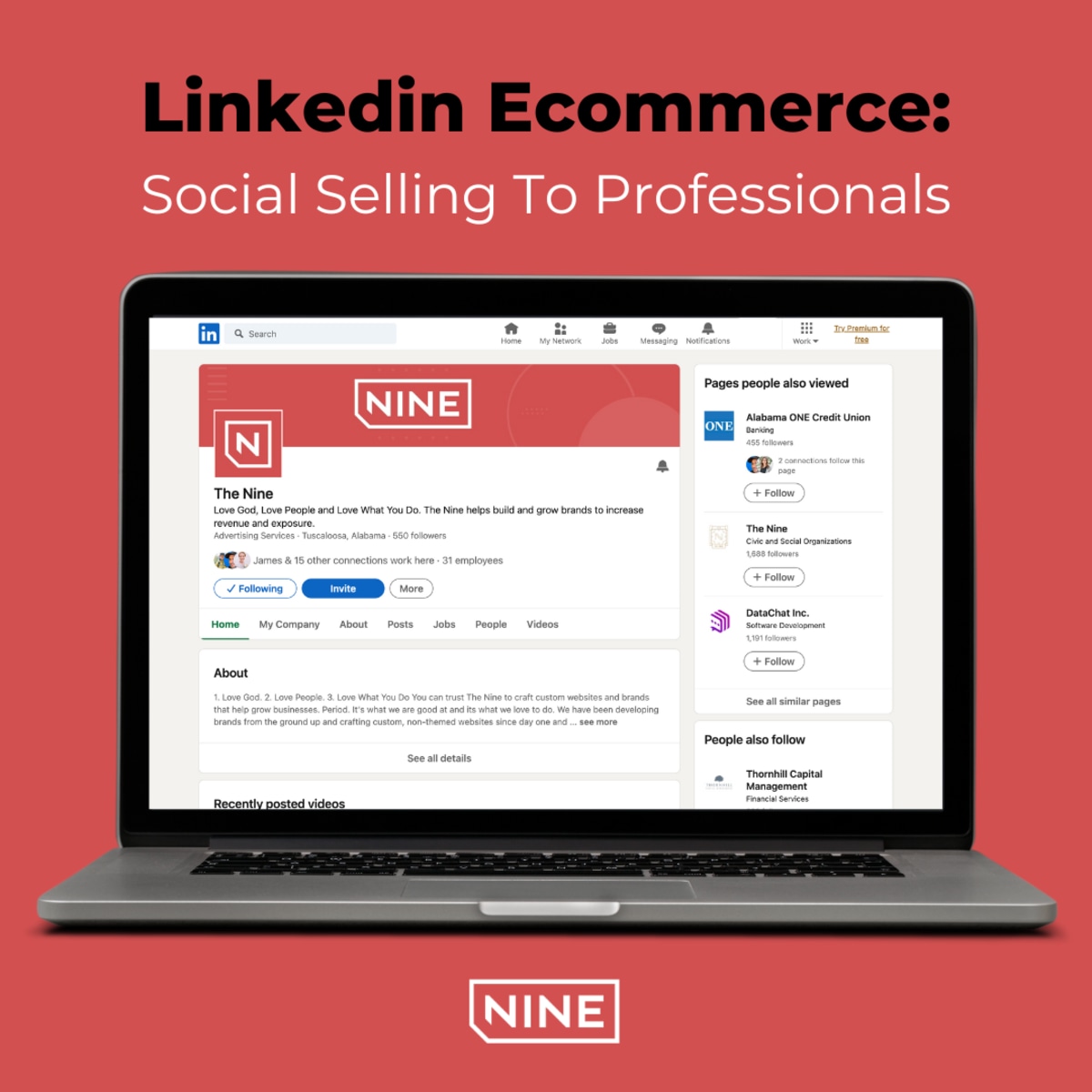
Any ecommerce brand aims to get in front of consumers interested in their products and then build a relationship to earn their business down the road. Ecommerce businesses accomplish this goal by penetrating the noise and having their message heard. LinkedIn Ecommerce is a social media platform primed for building relationships with customers who act more professionally than most other platforms.
What is LinkedIn Ecommerce?
LinkedIn ecommerce promotes your website through a LinkedIn sales page where you create engaging content that resonates with business professionals. Content on LinkedIn has the potential to be seen, whether shared by employees and followers or by LinkedIn members searching for terms and hashtags.
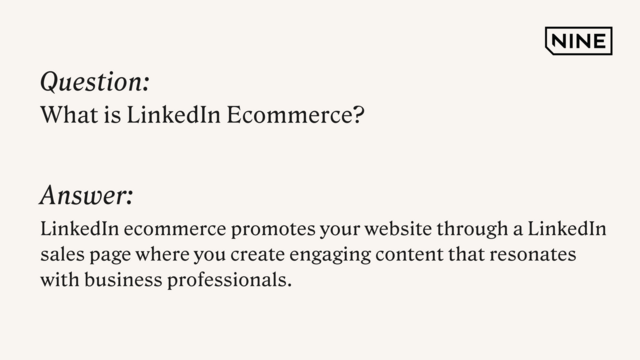
Ecommerce on LinkedIn also includes company owners and employees creating their unique brand content directly on their page.
The Benefits of Ecommerce On LinkedIn
Some say that B2C or D2C companies shouldn't invest in LinkedIn. That's just nonsense. While B2B is best suited for this platform, a creative strategy can help other business models find success different from other platforms. Since the lower competition, LinkedIn may have a better return on investment than TikTok, Instagram, or Facebook ecommerce.
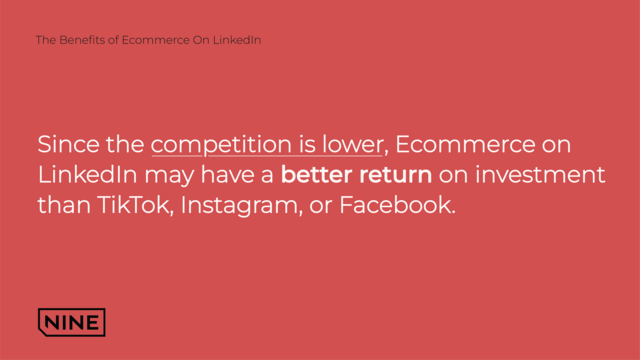
As it pertains to income, the user audience on LinkedIn has some of the best demographic statistics of any social media app. While they haven't quite reached Facebook (an older audience), the less restrictive algorithm makes visibility easier on LinkedIn.
Here are seven ways you can use LinkedIn to create commerce for your ecommerce business with
New product launches or back in stock.
Packaging redesigns that give new life to your products.
Product promotions and unique offerings.
Upcoming events where your products will be the topic.
News and media coverage that discusses your product category.
Changes within your industry
New members who join your team.
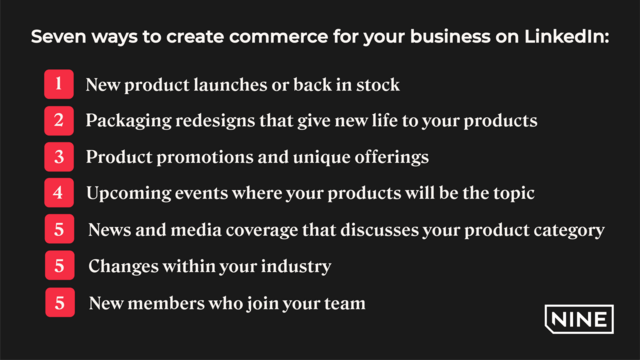
You might read some of these and say, "how does this fit into LinkedIn"? Good question. Look at the answers below.
Discuss how supply chain issues created back orders and how you worked to resolve them.
Walk followers through the design experience, including any consumer data you used to satisfy customers.
Align your product with a purpose and discuss how you are helping support a cause with the promotion.
Create social proof by attending an event with industry experts who respect the products you make.
Find and share media that supports the features you use as a differentiating product factor.
Find and align with industry transitions such as sustainability and feature the changes your company is making.
Give your new team members a voice and let them express their product-specific reasons they joined your company.
Additional Benefits
People want to join companies that have a heartbeat. With LinkedIn being a platform for job opportunities, your brand being an active platform member encourages better talent to come your way. Why? Because these candidates are more inclined to interview with your company because they understand and appreciate your products and purpose.
4-Types of LinkedIn Posts
Four primary ways to speak to your target audience within your business profile exist. The first two you are familiar with, but the last two are less common on other platforms. Each post type will require a unique strategy explicitly created for LinkedIn members.
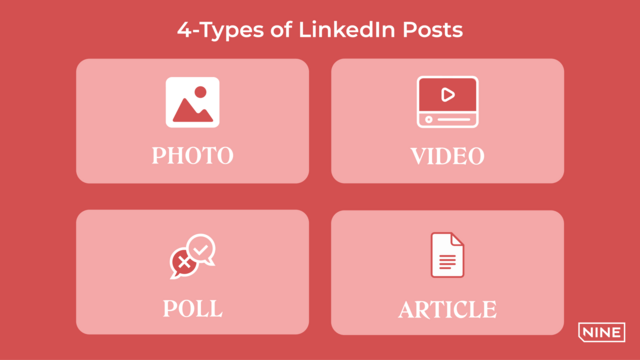
Photo
Where sometimes a selfie is still the right move, most times, posting static visuals such as infographics perform well on LinkedIn.
Video
A lesser-used feature is videos. Perhaps it's the desktop life most LinkedIn marketers have, but videos are the fastest way to go viral on this platform.
Polls
With user-generated content becoming a more critical part of social media marketing, ecommerce brands need to take action and start this conversation. Creating a poll on LinkedIn does precisely that.
Article
Not since Facebook has long-form content found a home. Creating a blog post within the platform showcases your professionalism and earns you more credibility with this astute audience.
What About Audio?
We didn't forget about audio formats. It's just that LinkedIn doesn't have a specific tab for audio creation. Perhaps they will look at some point, but you can still include audio in your posts, and we suggest it.
Business professionals are active listeners of podcasts. Creating podcast snippets, topic summaries, or industry briefs is a great way to jump into LinkedIn Marketing.
LinkedIn Content Marketing Strategies
The approach to content marketing requires a different thought process than typical ecommerce promotion.
Join LinkedIn Groups
Need a seemingly unlimited idea of what content to produce? Join groups where your potential customers are and monitor the group's activities for insights into what you should post. Even better, rather than trolling these groups, engage in the conversations by providing your expertise or understanding.
Repurpose Blog Articles
If you have an ecommerce SEO marketing strategy, you post blog articles to your website. Take your blog articles, summarize them, or create a new spin specific to LinkedIn.
Expand on Social Posts
Add context to your short-form social media posts to satisfy the LinkedIn audience. An easy way to do this is to post on Instagram on Monday, let the comments build, and then add any relevant information to your repurposed post on LinkedIn.
Include Team Members
With LinkedIn being the digital hangout for current and previous colleagues, posts that include company team members do well on this platform. Ecommerce brands can invite their employees to product launches, explanation videos, and industry updates. Putting a face on the brand and tagging them in the post ensures their connections also see it.
Cover Industry Topics
The emergence of social media gave brands the ability to take a chunk of the media market share for news coverage. Still an underutilized strategy for ecommerce marketing campaigns, LinkedIn is the perfect platform for such topic coverage.
Connecting With Followers
Aligning with the professionalism of LinkedIn, create a lunch & learn or happy hour where you invite a guest speaker to have a conversation with your audience.
Engage in Social Causes
Young professionals are increasingly making purchasing decisions based on the social causes of an ecommerce business. LinkedIn gives you the platform to show potential clients that you are engaged in “good for society” practices and are a purpose-driven business.
LinkedIn Best Practices
Sometimes you have to break the rules to capture attention, but on LinkedIn, there are specific practices that will help you align with the user audience.
Tone of Voice
Unlike other social platforms where slang is used to keep things short and have more fun, LinkedIn is created for and supportive of complete thoughts. Unless you make office jokes, the tone of voice needs to be positive, concise, and informative.
Thought Leadership
Thought leadership should be at the forefront of every post. What once lived on blog articles is now within the framework of this platform. Whether it's a post from the business owner or an employee, include unique expertise in every post.
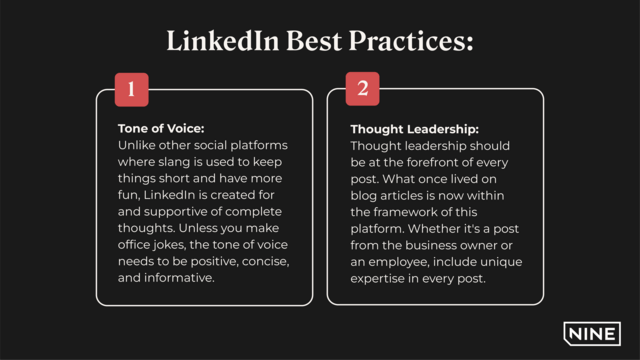
Digital Marketing Agency For Ecommerce Brands
At The Nine, We become the link between digital marketing and ecommerce revenues. As your digital ecommerce agency, our team will help you build an ecommerce marketing strategy for all social platforms, including LinkedIn. Schedule a time to speak with a member of our awesome team to learn more about how we help ecommerce companies scale from six to seven figures.

